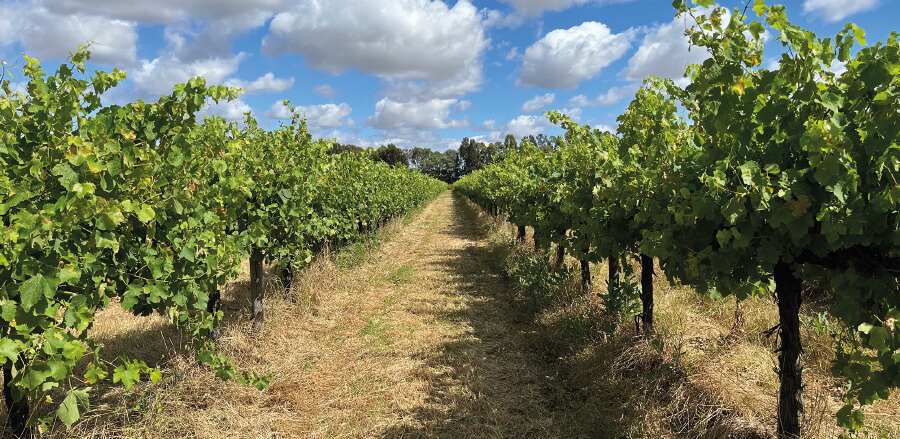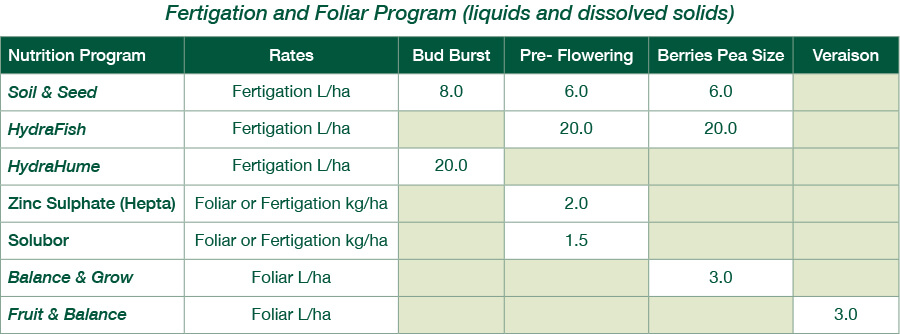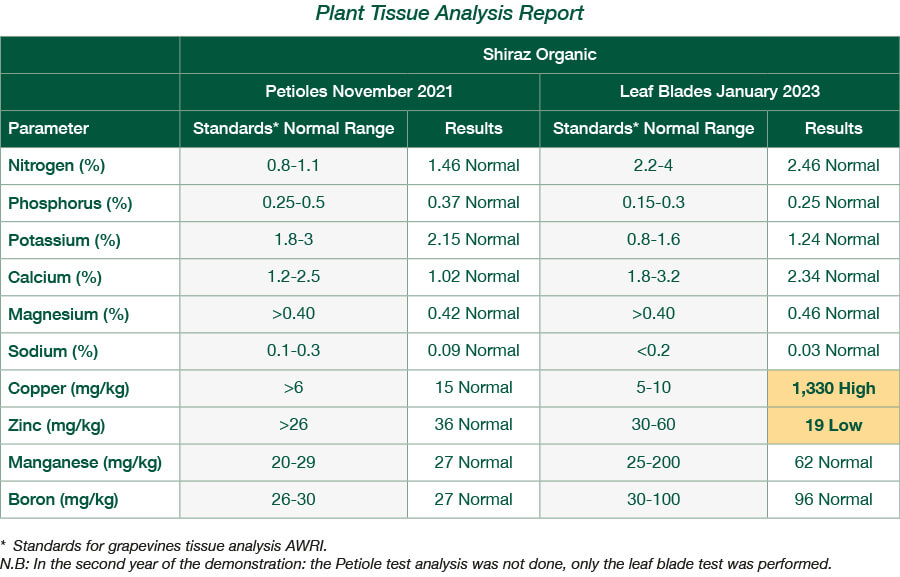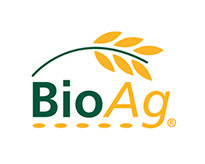
BioAg
Demonstration
Location
Riverina, NSW, Australia
Conducted by
Leading Australian Wine Producer
Organic wine grape vine demonstration
Investigating the benefits of a BioAg nutrition program for organic grapes, to evaluate the impact on grape harvest yield and quality.
Aim
To evaluate the impact of a bespoke BioAg soil nutrition program on the yield and quality levels of harvested organic grapes.

Method
Demonstration site size: 12ha
Vine varietals: Shiraz
Timeframe: May 2021 – March 2023, (harvest seasons 2022 and 2023)
A nutrition program was designed based on soil test analysis, yield objectives and historical issues at the block. Soil tests were performed prior to and at the end of each season (March 2021, April 2022, and August 2023).
The nutrition program utilised solid fertilisers with an ameliorant (gypsum) to improve soil nutrient status and soil physical properties. The objective at the start of the program was to maintain adequate to good levels of Phosphorus (P), Calcium (Ca) and Sulphur (S) levels, and to decrease Magnesium (Mg) and Sodium (Na) levels.
Trace elements Manganese (Mn), Zinc (Zn), and Boron (B) were identified as being moderate to low following initial soil analysis testing and were recommended to avoid micronutrient deficiencies, which was possible given a high soil pH.
Broadcast solid fertiliser and ameliorant blend was used once in May 2021, followed with foliar treatments in both 2021 and 2022 seasons, based on growth stage.

The program also included a range of BioAg biostimulants in combination with micronutrients at key growth stages. These biostimulants provide important nutrients and metabolites related to the stage of growth and are natural chelators of micronutrient salts aiding their adsorption and reducing losses to antagonists. Soil inoculants and run-off from foliar applications also feed soil biology increasing the numbers and diversity of beneficial soil micro-organisms, improving key properties related to soil biology (Soil & Seed® and HydraHume®), stimulating early vine vegetative growth (Balance & Grow®), and improving fruit set and development (Fruit & Balance®). Early season improvement in soil biology is of benefit as it stimulates root growth and improves nutrient cycling and availability by creating organic complexes that aid nutrient absorption.

Observations and Results
Review of the soil test results showed improvements in some soil structural and chemical properties.
An objective at the start of the program was to maintain adequate to good levels of Ca, P and S.
This was achieved with one application of BioAgPhos® and Gypsum at the beginning of the demonstration. With the addition of Ca and S, the cation exchange complex has slightly improved, replacing Na and Mg with Ca and consequently improving the Ca:Mg ratio. Improving the ratio is important as it enhances a soil’s water conductivity, especially in soils with high Mg and K.
There was an overall improvement in the cations’ balance, while P levels were maintained (note Colwell P will typically not measure all plant available P when using RPR based fertilisers). The improvement in cation balance also resulted in an improvement in soil pH, which increases the availability of trace elements, such as Zn, B, Fe.
Key improvements are highlighted below.

Tissue tests were used at critical growth stages to monitor nutrient levels in the vines, and to ensure applied nutrients were being used by the vines.

During the Demonstration, all the nutrients were within an acceptable range with the exception of Copper (Cu) and Zinc (Zn) in January of 2023. The high Cu level in the January 2023 Leaf test is due to applications of Cu to combat the increased incidence of Downy Mildew during a mild season. Significantly, it was noted that the demonstration block exhibited lower incidence of Downy Mildew to other blocks, including conventional Shiraz grape production.
Applied biostimulants produced a positive effect on both nutrient availability and crop resilience to disease.
The 2021 to 2023 seasons were colder and wetter than normal / average seasons. While the nutrition program ensured vines had access to all critical nutrients (per plant tissue tests), the climatic conditions impacted both the yield and quality of the grapes.

Yields of around 10T/ha in organic production are considered ‘good’. The impact of weather conditions was also evident in the yield results at a conventional block of the same Shiraz variety which were below 10T/ha in 2022 (target yield for conventional systems is in the range of 18 to 22T/ha).
Summary
The two-year demonstration of BioAg’s organic nutrition program provided:
• An improvement in soil physical and chemical properties.
• Required levels of macro and micronutrients in the vines (as measured in tissue tests).
• An ability to defer maintenance applications of solid fertiliser to every 2nd or 3rd year, offering an opportunity to reduce costs.
• Increased crop resilience to mildew.
• Improvements in baume and colour.
The variability experienced across the seasons highlights that some external factors such as weather will significantly impact yields and quality beyond any influence of a nutrition program. This is also true if there are differences in pruning or disease mitigation.
While the program was implemented, the season was challenging and not as hoped. Cool and wet conditions hindered growth across all the grower’s operations (conventional and organic). However, the wet conditions highlighted the benefit of post-harvest solid fertiliser applications to support recovery and nutrient uptake prior to dormancy which in turn supports early season vigour, as well as the benefit of supporting vines during key growth stages with foliar biostimulants.
Despite the wet and cool conditions, the grower noticed a significant improvement in crop growth throughout the season compared to prior years. The weather conditions brought with it a higher risk and increased occurrence of Downy Mildew and Botrytis across the entire vineyard. The BioAg demonstration block however, suffered fewer incidents of disease compared to all other blocks, including the chemically treated conventional blocks. By supporting early growth and key growth stages, the vines were stronger and healthier and therefore better able to combat disease and stress themselves, without the need for additional chemical treatments.
Given the measured results in soil and plant tests, it is evident that the nutrition program worked well. The Vineyard Manager is now incorporating the program into conventional operations across other vineyard sections. Measuring yield and quality results in a more typical year will continue to reinforce and provide a clearer indication of the benefits associated with a BioAg organic program.
Download demonstration
For the full demonstration, including methods, results and conclusion, download here.

Recent Comments